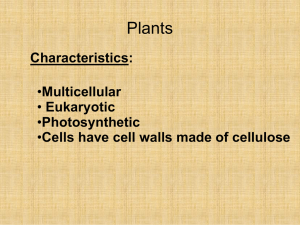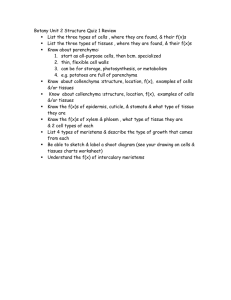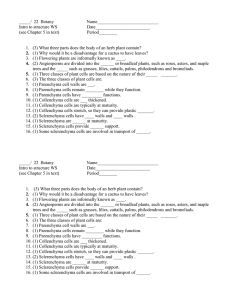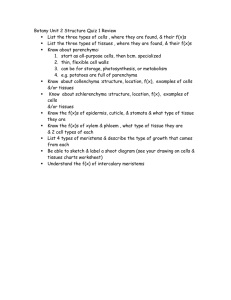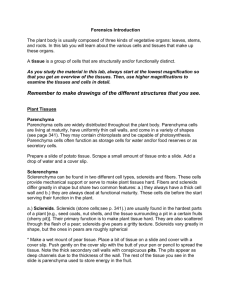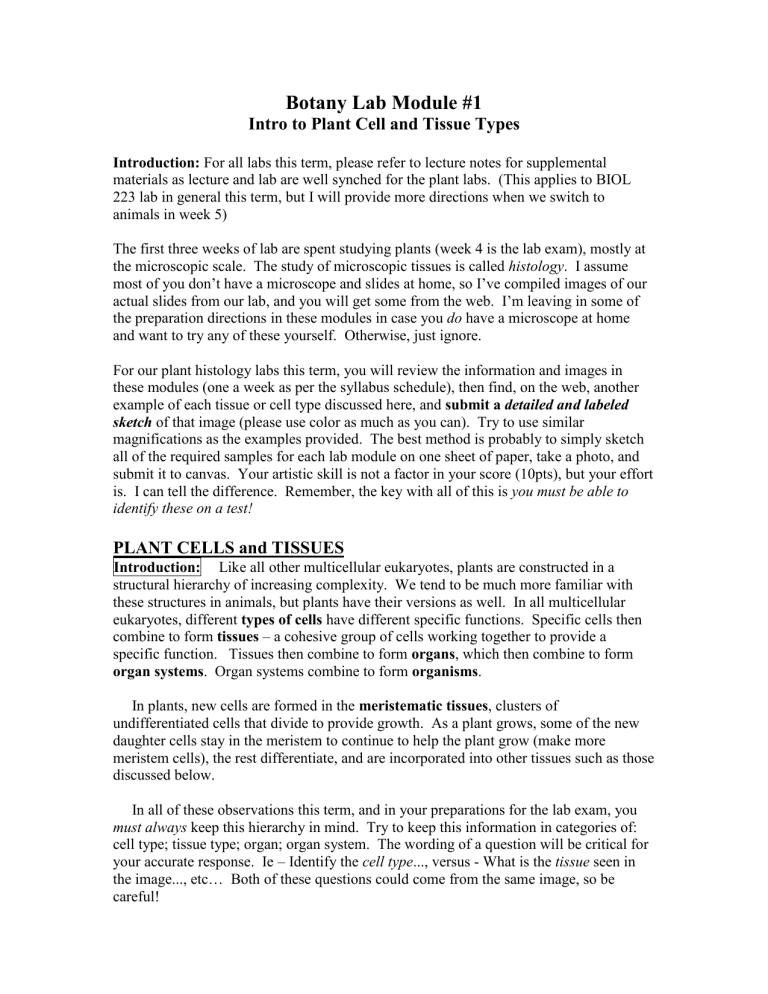
Botany Lab Module #1
Intro to Plant Cell and Tissue Types
Introduction: For all labs this term, please refer to lecture notes for supplemental
materials as lecture and lab are well synched for the plant labs. (This applies to BIOL
223 lab in general this term, but I will provide more directions when we switch to
animals in week 5)
The first three weeks of lab are spent studying plants (week 4 is the lab exam), mostly at
the microscopic scale. The study of microscopic tissues is called histology. I assume
most of you don’t have a microscope and slides at home, so I’ve compiled images of our
actual slides from our lab, and you will get some from the web. I’m leaving in some of
the preparation directions in these modules in case you do have a microscope at home
and want to try any of these yourself. Otherwise, just ignore.
For our plant histology labs this term, you will review the information and images in
these modules (one a week as per the syllabus schedule), then find, on the web, another
example of each tissue or cell type discussed here, and submit a detailed and labeled
sketch of that image (please use color as much as you can). Try to use similar
magnifications as the examples provided. The best method is probably to simply sketch
all of the required samples for each lab module on one sheet of paper, take a photo, and
submit it to canvas. Your artistic skill is not a factor in your score (10pts), but your effort
is. I can tell the difference. Remember, the key with all of this is you must be able to
identify these on a test!
PLANT CELLS and TISSUES
Introduction: Like all other multicellular eukaryotes, plants are constructed in a
structural hierarchy of increasing complexity. We tend to be much more familiar with
these structures in animals, but plants have their versions as well. In all multicellular
eukaryotes, different types of cells have different specific functions. Specific cells then
combine to form tissues – a cohesive group of cells working together to provide a
specific function. Tissues then combine to form organs, which then combine to form
organ systems. Organ systems combine to form organisms.
In plants, new cells are formed in the meristematic tissues, clusters of
undifferentiated cells that divide to provide growth. As a plant grows, some of the new
daughter cells stay in the meristem to continue to help the plant grow (make more
meristem cells), the rest differentiate, and are incorporated into other tissues such as those
discussed below.
In all of these observations this term, and in your preparations for the lab exam, you
must always keep this hierarchy in mind. Try to keep this information in categories of:
cell type; tissue type; organ; organ system. The wording of a question will be critical for
your accurate response. Ie – Identify the cell type..., versus - What is the tissue seen in
the image..., etc… Both of these questions could come from the same image, so be
careful!
Background: The tissues of higher plants can be grouped as follows:
(1) Meristems (lab module 2/3) – Undifferentiated cells that divide to provide
growth, of which there are two types:
a. Apical meristems – function in primary growth to increase the
length/height of the plant.
b. Lateral meristems – function in secondary growth to increase the diameter
of the plant. (these do not make branches, a common point of
confusion)(generally only present in woody plants)
(2) Mature permanent tissues – which are of three general types:
{1} Dermal tissues - Outer layered cells making coverings of plant bodies, of
which there are two specific types:
a. Epidermis
b. Periderm
{2} Ground tissue – Provide many basic functions such as structural support,
photosynthesis, storage, barriers, and other metabolic necessities. Four
specific types:
a. Parenchyma
b. Collenchyma
c. Sclerenchyma
d. Endodermis (not actually dermal)
{3} Vascular tissue (lab module 2/3) – Allow bulk flow of materials
throughout a plant, of which there are two specific types:
a. Xylem
b. Phloem
In histology tissues are sectioned, cut in specific planes for specific views. This can be
one of the most difficult parts of histology,... visualizing the tissue in its greater context.
That begins with knowing the section type. The appearance may change significantly
depending on the section type. Always remember, these things are still three
dimensional, no matter how thinly they are sliced. See the image below to understand
section orientation.
In addition to sectioning, another issue in histology is staining. Almost all cells are
naturally clear (except pigment cells, etc). To provide more contrast and visual detail,
most histological preparations are made using differential stains. These stain specific
structures in specific colors. These colors are specific to the stain method used. The
stain method chosen depends on what you are trying to highlight.
The vast majority of basic histology slides are prepared using H&E stains (hematoxylin
and eosin). Therefore, when a particular structure is a certain color, it will always be that
color, if H&E is used. This helps us in our ID’s significantly. Use these colors in your
memorization. Greens in plants, of course, are due to the chloroplasts/chlorophyll. Most
of the prepared slides (not fresh) that we will use are prepared in H&E stain.
Activity:
DERMAL TISSUES
Epidermis
The outermost layer of the plant is the epidermis. This layer lacks chloroplasts but
functions in preventing water loss from the plant. For this portion of the lab we will
examine a thin section of the bottom surface of a leaf from a Zebrina plant. Normally
you would tear the leaf in two sections as show below:
Select a small portion of the lower epidermis from the torn margin (see small square in
the photo above). Prepare a wet mount using distilled water. Look at the under portion
of the leaf epidermis under high magnification. We are looking for Guard Cells. They
regulate the stoma (opening) size to control the passage of water and gases. The guard
cells look something like this:
The green cells are the guard cells, the slit that looks like the pupil of a cat eye is the
stoma. The other pinkish cells are the rest of the epidermal cells. This is a sheet section,
not a cross section (cs or xs) or a longitudinal section (ls).
This is another image of guard cells and their stomata. The green structures in the guard
cells are chloroplasts.
To turn in: Find another photo on the web of a plant epidermis with guard cells. Sketch
and label it. Provide the magnification if known. (If you do have a scope at home, feel
free to try to make your own slide for this one!)
PERIDERM Periderm tissue is a more complex form of dermal tissue that occurs only
in woody plants like trees and shrubs (anything with bark). Cork cells make up the most
abundant part of the periderm tissue in woody plants. In this exercise we will examine
cork cells.
(1) Make a very thin section of cork. Do not add water or use a cover slip.
(2) Examine the tissue at 100X and 400X magnifications.
(3) Notice the fairly uniform size and general appearance of these cells. These are
dead cells with no internal contents, just a thick, waxy cell wall. Your slide
should look like the photos below:
Cork cells 100X
Cork cells 400X
To turn in: Find another photo on the web of cork cells. Sketch and label the image.
Provide the magnification if known. (you can make this one too)
GROUND TISSUES
Cell Type
Cell Walls
Parenchyma
Collenchyma
primary only
primary only
Sclerenchyma primary and secondary
Description
Large cell, thin wall
Small cell, unevenly
thick 1’ cell wall
Variable size, massively
thick 2’ cell wall
Alive or dead @
maturity?
alive
alive
dead
Collenchyma - is a simple tissue composed of elongated cells with tapered ends. In
cross section you should see small cells with irregularly thickened primary cell walls.
In this exercise we will examine Collenchyma cells in celery.
(1) Make a wet mount of a very thin cross-sectional piece of celery. Take the tissue
from the celery as shown below:
(2) On low power (40X) locate the small clusters of light and dark grey cells found in
"little islands" of tissue in a ring around the outside of the celery. It should look like the
picture below at 40X magnification.
These are strands of collenchyma tissue, making up the "celery strings". They
function as support tissue in the subdermal area of the celery petiole (leaf stalk).
(3) Add a drop of neutral red stain to the slide. Place a drop on one side of the cover
slip and draw it through to the other side using a paper towel as a wick. It should look
like the picture below a 100X magnification.
Collenchyma - Dark areas are
the cytoplasms, light areas
are the cell walls. Notice how
the walls are variably thick
and thin. (unstained)
Parenchyma – look like large soap bubbles
Collenchyma cells stained with neutral red 100X
Notice the characteristic irregular thickness of the cell walls.
To turn in: Find another photo on the web of collenchyma (celery). Sketch and label the
image. Provide the magnification if known. (you can make this one too)
Parenchyma – is the most common kind of plant tissue. It is found in all parts of the
plant (roots, stems, leaves, flowers and fruit). It makes up the bulk of the body of a
herbaceous plant.
(1) On the same slide of cross section of celery stalk look for the larger cells in the
center of the petiole. It should look like the photograph below.
Celery Parenchyma cells stained with neutral red 100X
Notice the thin cell walls and the intercellular spaces (air spaces between the cells where
three or four cells are in contact (filled with stain).
To turn in: Find another photo on the web of parenchyma cells. Sketch and label the
image. Provide the magnification if known. (you can make this one too)
Sclerenchyma cells have thick secondary walls and are dead at functional maturity. The
cells walls are thick and hard and contain lignin. In contrast to collenchyma,
sclerenchyma tissue has cell walls that are evenly thickened. There are two types of
sclerenchyma cells: elongated sclerenchyma fibers and sclereids (come in a variety of
shapes).
Sclereids
(1) Prepare a wet mount of a very small amount of the fleshy part of a pear.
(2) On low magnification you should notice clusters of sclereids that should look like
the photograph below:
Sclereids – small
cheerios in
clusters. Opening
in center is
cytoplasm. Notice
how
comparatively
thick the cell walls
are. Other cells
here are
parenchyma
Sclerenchyma Fibers are elongated sclerenchyma cells with thick cell walls and
small lumens. They are found in association with vascular bundles, forming a bundle cap
of cells just outside the phloem.
(1) Look at a prepared slide of Helianthus (Sunflower) on low power (40X)
The clusters of cells that form a ring around the periphery of the stem are vascular
bundles (magenta in H&E stain with clear cytoplasms). They should look something
like the photograph below:
Phloem
Xylem
Sclerenchyma
bun(bundle cap)
Toward the outside of each vascular bundle is a cluster of sclerenchyma fibers. Examine
them on high magnification. They should look something like the photograph below on
100X magnification:
Note the thick walls and small central lumen of each cell
On the photograph below the thick walls and small lumens are even more obvious.
To turn in: Find photos on the web of scherenchyma fibers AND sclereids. Sketch and
label each image. Provide the magnifications if known.
(To sum up for this first time, you will be submitting labeled drawings of 5 different cell
types. These are due by 5pm Friday of week one. Please contact me with any questions.
Remember, you are doing more than just drawings, but also learning these so you may
identify them on the exam. You will need to practice them. Making flashcards of them
is a great way to go.)
